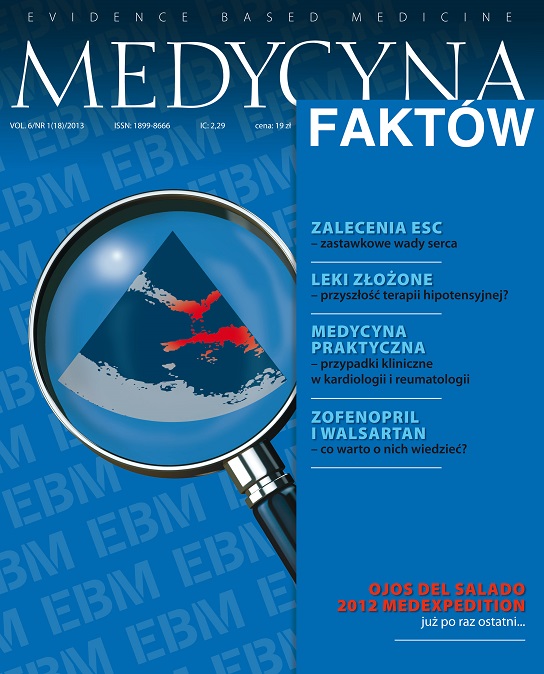Nearest future of hypotensive therapy ? combined drugs? Review article
Main Article Content
Abstract
Arterial hypertension is one of the most prevalent cardiovascular risk factors all over the world. Its therapy has a fundamental importance in reduction of cardiovascular morbidity and mortality. Among modern forms of hypotensive therapy the use of combined drugs is listed. Combined drugs provide better control of blood pressure than drugs use as separate preparations, improve compliance, reduce side effects and offer lower costs of therapy. Currently inhibitors of renin?angiotensin system and diuretics or calcium antagonists are most often combined together. An interesting combination is that of combining perindopril and amlodipine. Efficacy of the former was confirmed in many studies in patients with hypertension, coronary artery disease, after stroke and in these with diabetes. The latter was also effective in similar populations. Combination of perindopril and amlodipine is highly effective in blood pressure reduction and is well tolerated.
Article Details
Copyright © by Medical Education. All rights reserved.
References
2. Wolf-Maier K., Cooper R.S., Kramer H. et al.: Hypertension treatment and control in five European countries, Canada, and the United States. Hypertension 2004; 43: 10-17.
3. Hansson L., Zanchetti A., Carruthers G. et al. for the HOT Study Group: Effects of intensive blood-pressure lowering and low-dose aspirin in patients with hypertension: principal results of the Hypertension Optimal Treatment (HOT) randomized trial. Lancet 1998; 351: 1755-1762.
4. Mourad J.J., Waeber B., Zannad F. et al.: Comparison of different therapeutic strategies in hypertension: a low-dose combination of perindopril/ indapamide versus a sequential monotherapy or a stepped-care approach. J. Hypertens. 2004; 22: 2379-2386.
5. Weber M.A., Julius S.T., Kjeldsen S.E. et al.: Blood pressure dependent and independent effects on antihypertensive treatment on clinical events in the VALUE Trial. Lancet 2004; 363: 2047-2049.
6. Wytyczne Polskiego Towarzystwa Nadciśnienia Tętniczego. Zasady postępowania w nadciśnieniu tętniczym ? 2011 rok. Nadciśnienie Tętnicze 2011; 15: 55-82.
7. The Task Force for the Management of Arterial Hypertension of the European Society of Hypertension and of the European Society of Cardiology. 2007 Guidelines for the Management of Arterial Hypertension. J. Hypertens. 2007; 25: 1105-1187.
8. Guidelines Committee: 2003 European Society of Hypertension ? European Society of Cardiology guidelines for the management of arterial hypertension. J. Hypertens. 2003; 21: 1011-1053.
9. Mancia G., Laurent S., Agabiti-Rosei E. et al.: Reappraisal of European guidelines on hypertension management: a European Society of Hypertension Task Force document. J. Hypertens. 2009; 27: 2121-58.
10. Dahlof B., Sever P.S., Poulter N.R. et al.; ASCOT Investigators: Prevention of cardiovascular events with an antihypertensive regimen of amlodipine adding perindopril as required versus atenolol adding bendoflumethiazide as required, in the Anglo-Scandinavian Cardiac Outcomes Trial-Blood Pressure Lowering Arm (ASCOT-BPLA): a multicentre randomized controlled trial. Lancet 2005; 366: 895-906.
11. Williams B., Lacy P.S., Thom S.M. et al.; CAFE Investigators; Anglo-Scandinavian Cardiac Outcomes Trial Investigators; CAFE Steering Committee and Writing Committee: Differential impact of blood pressure-lowering drugs on central aortic pressure and clinical outcomes: principal cresults of the Conduit Artery Function Evaluation (CAFE) study. Circulation 2006; 113(9): 1213-1225.
12. Jamerson K., Weber M.A., Bakris G.L. for the ACCOMPLISH trial investigators: Benazepril plus Amlodipine or Hydrochlorothiazide for Hypertension in High-Risk Patients. N. Engl. J. Med. 2008; 359: 2417-2428.
13. NICE2011 hypertension guidelines.
14. Feldman R.D., Zou G.Y., Vandervoort M.K. et al.: Randomized, Controlled Trial A Simplified Approach to the Treatment of Uncomplicated Hypertension: A Cluster, randomized, controlled trial. Hypertension 2009; 53: 646-653.
15. Strauss M.H., Hall A.S.: Angiotensin receptor blockers may increase risk of myocardial infarction: unraveling the ARB-MI paradox. Circulation 2006; 114: 838-854.
16. The ONTARGET Investigators: Telmisartan, Ramipril, or Both in Patients at High Risk for Vascular Events. N. Engl. J. Med. 2008; 358: 1547-1559.
17. PREAMI: Perindopril and Remodelling in Elderly with Acute Myocardial Infarction: study rationale and design. Cardiovasc. Drugs Ther. 2000; 14: 671-679.
18. Fox K.M.: European trial on reduction of cardiac events with perindopril in stable coronary artery disease investigators: Efficacy of perindopril in reduction of cardiovascular events among patients with stable coronary artery diseased: randomized, double-blind, placebo-controlled, multicenter trial (the EUROPA study). Lancet 2003; 362: 782-788.
19. ADVANCE Collaborative Group: ADVANCE ? Action in Diabetes and Vascular Disease: patient recruitment and characteristics of the study population at baseline. Diabetic Medicine 2005; 22: 1-7.
20. PROGRESS Collaborative Group: Randomised trial of a perindopril-based blood-pressure-lowering regimen among 6,105 individuals with previous stroke or transient ischaemic attack. Lancet 2001; 358(9287): 1033-1041.
21. Beckett N.S., Peters R., Fletcher A.E. et al. for the HYVET Study Group: Treatment of Hypertension in Patients 80 Years of Age or Older. N. Engl. J. Med. 2008; 358: 1887-1898.
22. Bahl V.K., Jadhav U.M., Thacker H.P.: Management of hypertension with the fixed combination of perindopril and amlodipine in daily clinical practice: results from the STRONG prospective, observational, multicenter study. Am. J. Cardiovasc. Drugs 2009; 9: 135-142.

